Although the 3 factors for healthy growing air plants are water, light and nutrients, the environment plays a role too.
What conditions do air plants like?
An air plant environment needs bright, filtered light (direct sunlight only for mesic types), good air circulation, a temperature between 12°C (54°F) to 30°C (86°F) and 50 to 70% humidity levels.
How can you achieve this? Let’s dig in deeper!
Air Plant Environment
What an air plant needs to thrive is closely related to the environment you intend to grow your Tillandsia. The air plant environment factors are:
- Light.
- Air.
- Temperature.
- Humidity.
These will determine where you will put your air plants (which rooms, indoors or outdoors) and how you will display them too (terrarium, wood, etc.).
Air Plant Light Needs
Air plants need bright, filtered light to survive. How much light a Tillandsia needs depends on its type: a mesic (prefer indirect sunlight) or xeric type (prefer bright direct sunlight).
If your air plant is exposed to too much sunlight, its moisture will get depleted. This can cause them to get sunburn and eventually die if they are left in the sun too long.
On the other side of the spectrum, your air plant could be getting too little light. If your air plant turns much lighter in colour, it’s telling you that it needs more daylight.
Read also: Air Plant Light Guide – How Much Light Do They Need.
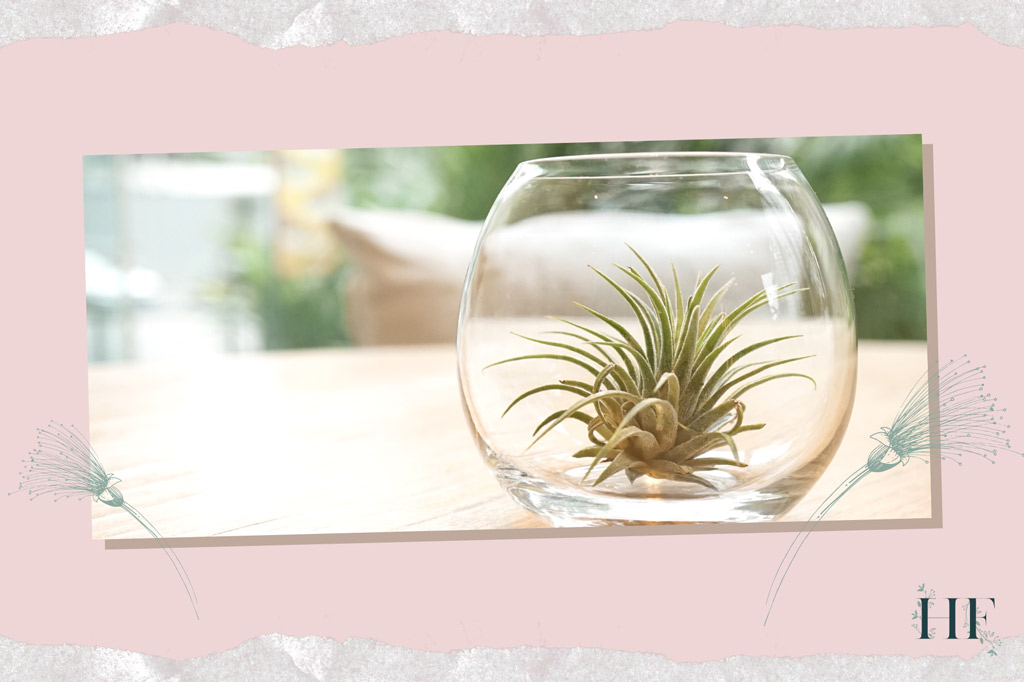
Air Plant Airflow Needs
Air plants need air circulation, not staleness. The airflow allows these plants to absorb nutrients, dry out after watering and remain healthy. If an air plant doesn’t absorb enough air, it will wither away and die.
Since Tillandsias evolved in sites that all have high airflow, it’s important to provide a well-ventilated location and display. If the air is hot, some ventilation will cool down the plant and keep it from becoming overheated.
Mesic air plants will tolerate less air movement (or ventilation) and a more humid environment. However, xeric air plants need good and unobstructed air circulation.
Enclosed display options like terrariums don’t provide enough air circulation, especially when the opening is small.
You can use a fishbowl with no lid, but air plants thrive best in an open display (like mounted in wood or standing on a rock), so they get plenty of air around them.
Insider Tip: If you want to use a glass display, use a globe with the biggest opening you can find to ensure good air circulation. Aeriums are special globes designed for air plants.
Also, after watering, make sure you allow your Tillandsia to dry for 3 to 4 hours before putting it back into the display. If the air plant is wet or moist, it will rot away.
Read also: Air Plant Watering Guide – How to Water and Mist Tillandsias.
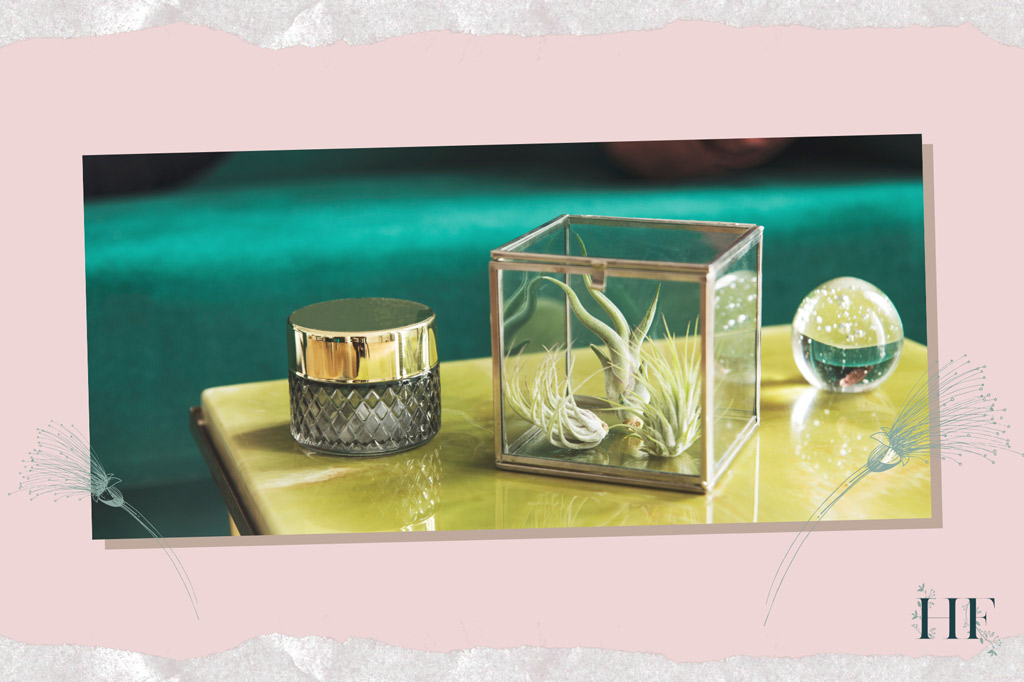
Air Plant Temperature Needs
Air plant temperature needs to be 12°C (54°F) at its lowest and 30°C (86°F) at its highest. Tillandsias thrive in warmer temperatures; they can’t survive in the winter frost (source).
In other words, air plants will be pretty happy inside the average home, temperature-wise. However, the average home probably lacks humidity.
The Tillandsia genus is native to Mexico and the southeastern United States, Central and South America, including the Caribbean, where the temperature is warm and there’s humidity.
Read also: Air Plant Origin and 5 Most Common Tillandsia Varieties.
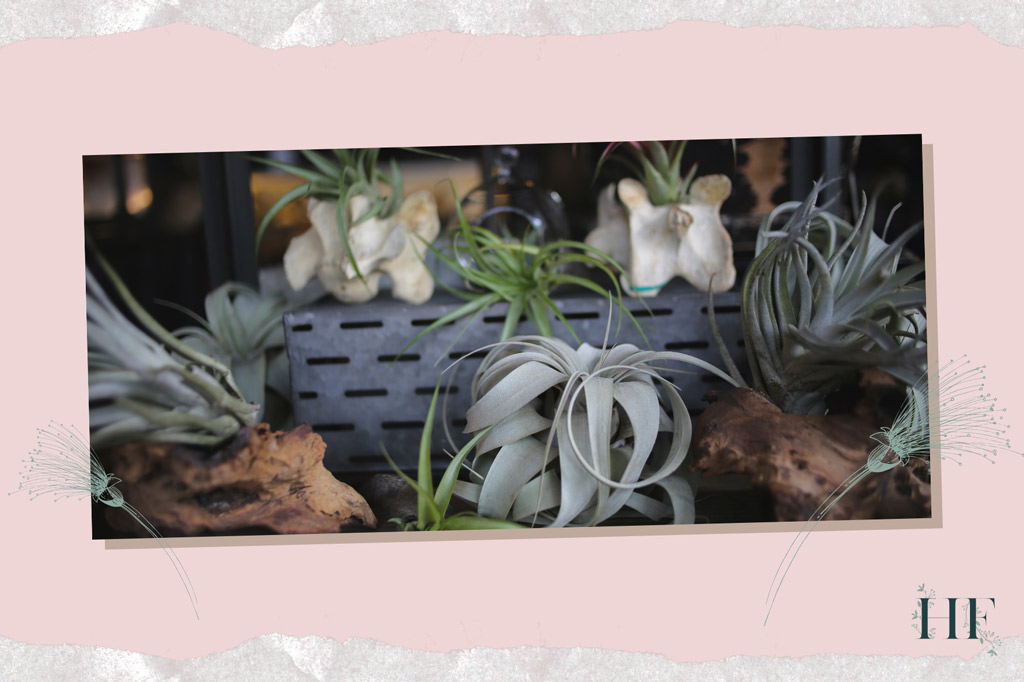
Air Plant Humidity Needs
Air plant humidity needs to be between 50 to 70%. Mesic air plants do better in moderate humidity. Xeric types, however, thrive in high humidity climates.
In most homes, the humidity won’t be nearly as high – the average indoor humidity level falls between the 40 to 60% range. This means that there is less water around for the air plant to absorb through air moisture.
That’s why you need to mist air plants and also soak them; they won’t survive without supplemental watering.
You can measure both the temperature and humidity of your home by using a hygrometer – that’s the one I use.
Insider Tip: As a general rule of thumb, the higher the humidity in your environment or space, the more light an air plant will tolerate.
The more direct light an air plant gets, the more depleted its moisture content will be.
Read also: Air Plant Care – 8 Steps to Grow and Keep Tillandsias Alive.
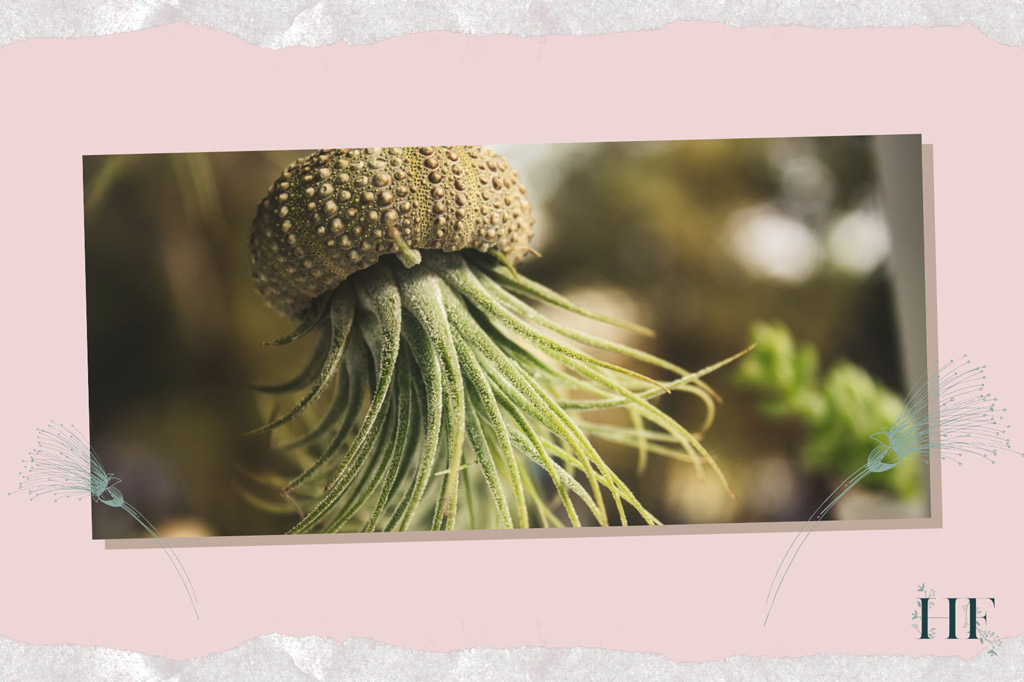
Where to Put Air Plants
After going through air plants’ requirements related to their environment, next comes where to put them.
Can you keep an air plant outside or inside? And where do air plants grow best?
Air Plants Indoors
If you keep your air plants indoors, keep them close to a window and water them frequently. Xeric air plants can stay on the windowsill and need less watering. But keep mesic air plants away from direct sunlight, but not too far from the light source either and water them more frequently.
“Air plants can be kept inside all year as long as they are getting frequent watering.”
Andrew Gavin from Andy’s Air Plants.
Finding the right spot can be tricky and you need to take into account two things:
- The climate: Where you live, i.e., the climate in your area – humidity and temperature levels.
- Low humidity and high temperatures: In areas that lack humidity (dry climate), your plants will damage and dry out from the direct sunlight even quicker. Xeric types are better suited for this climate.
- High humidity and high temperatures: You need to keep your mesic air plants away from direct sunlight but they will keep moist for longer thanks to the humidity levels.
- Window orientation: From what direction is the light coming from? i.e., the window orientation – south, east, west or north-facing.
- Southern or eastern facing windows: these spaces will be brightly illuminated by the sun for most of the day.
- North-facing windows: these spaces might not get enough light (especially if trees and buildings block the sun) and can get cold in winter.
- West-facing windows: The light tends to come late in the day, and can be very hot and intense. You need to be careful if you don’t want to fry your air plant!
Insider Tip: As a rule of thumb for indoor plants, don’t place them more than 10 feet (3m) from a window.
You could also keep your Tillandsia closer to a window that is partly shaded, either from a tree or a building, i.e., any other kind of protection from the direct sun.
Once you decide where you want to display your air plant, let it acclimate and keep an eye to see how it’s doing.
Air Plants in the Bathroom
A brightly lit bathroom where the steam is regular and plentiful, it’s an ideal indoor location for air plants. The humidity from your shower will take care of most plant misting for you.
A kitchen can be another good alternative to display your Tillandsias since, along with the bathroom, it’s another room in the house that tends to have higher humidity levels.
Insider Tip: Keep air plants away from fans, radiators, and fires.
Read also: 10 Air Plant Display Ideas that Won’t Harm Tillandsias.
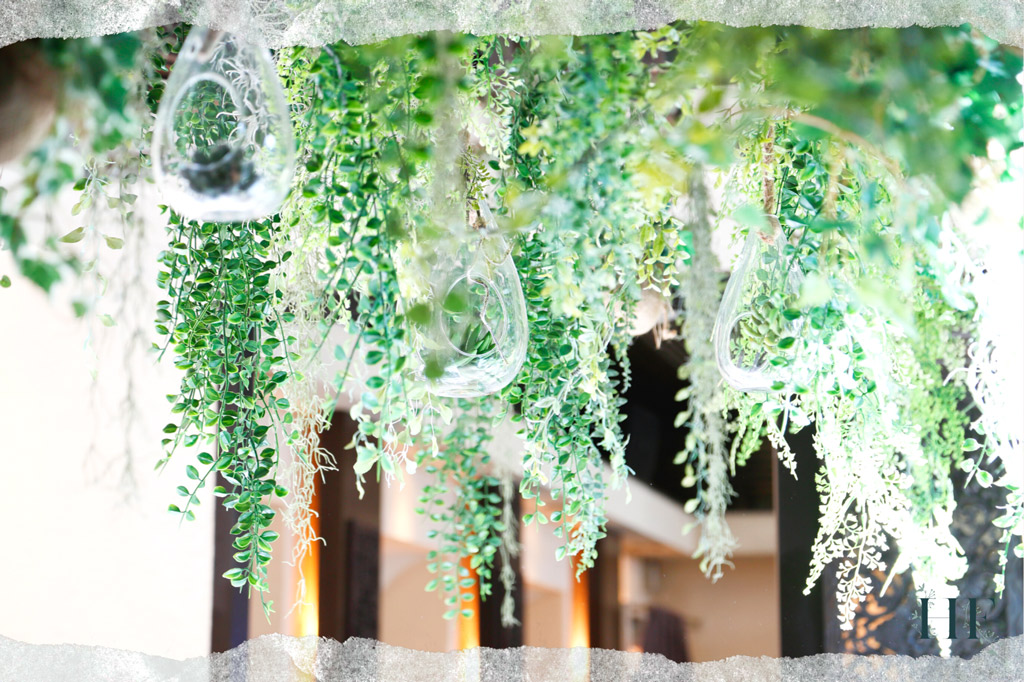
Air Plants Outdoors
During warmer months, you can take your air plants outdoors in partially shaded areas for the mesic group. Xeric air plants can take direct sunlight. Make sure to bring them back indoors before the first frosts and when the temperature goes below 12°C (54°F).
“Air plants can also be kept outside from spring to autumn and brought back inside for the winter.”
Andrew Gavin from Andy’s Air Plants.
That is unless you live where that air plant is originally from! In frost-free climates, air plants can live outside for the entire year.
If you keep your air plants outdoors, the same guidelines that I gave above still apply. Generally, keep them in an area where the sun won’t directly hit them.
For instance, you can display your air plants outdoors in the following locations:
- Under a tree.
- In a shaded porch, patio or balcony.
However, xeric air plants like T. xerographica and T. Tectorum can be displayed in a sunnier spot.
Finally, you will want to be careful if you have any pets. Air plants are not toxic to dogs and cats, but being pet-friendly doesn’t mean that there’s no risk of your furry friend chewing on them.
You can find out more about How to Make Your Home Dog-Friendly and How to Make Your Garden Dog-Friendly.
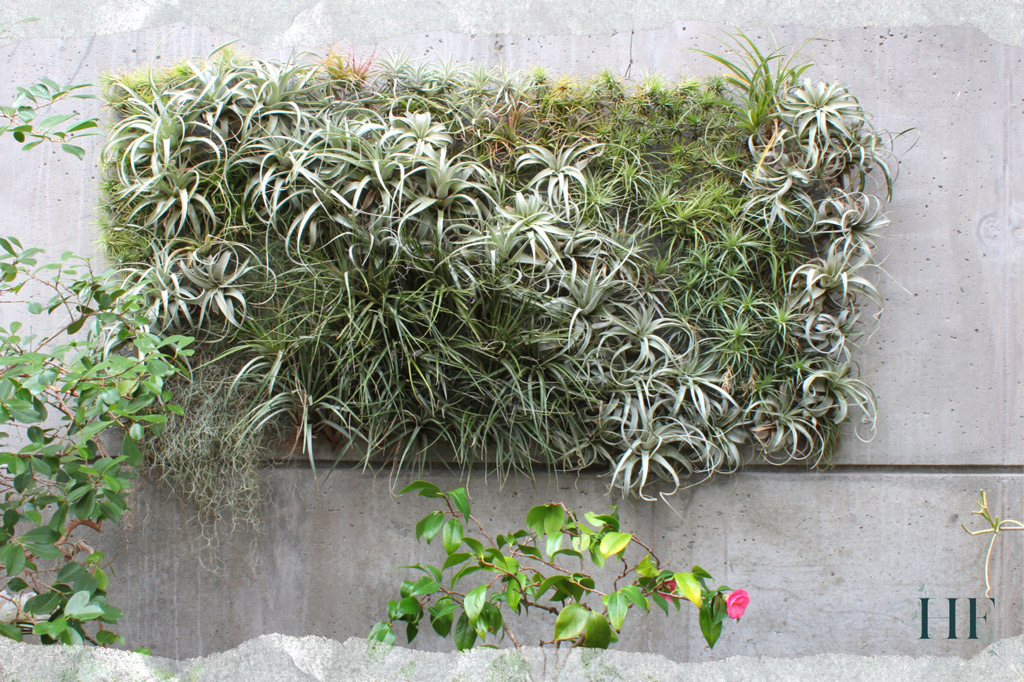

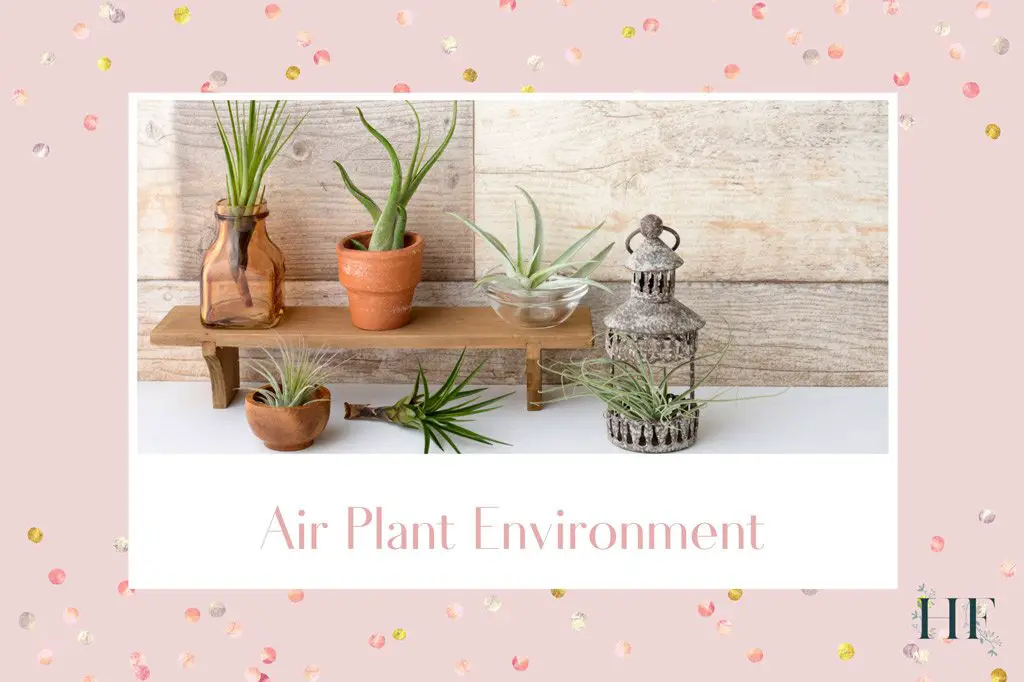
Can I put himilayan salt in a terrarium with an air plant? I have been told that it is OK as long as the air plant doesn't touch the salt. Thanks!